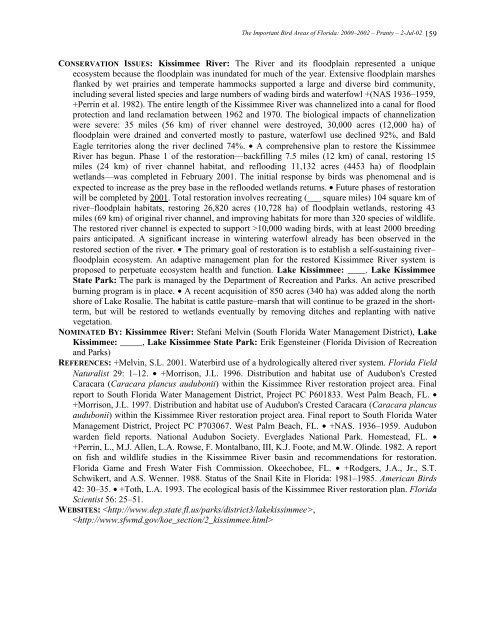The Important Bird Areas of Florida - National Audubon Society
The Important Bird Areas of Florida - National Audubon Society
The Important Bird Areas of Florida - National Audubon Society
Create successful ePaper yourself
Turn your PDF publications into a flip-book with our unique Google optimized e-Paper software.
<strong>The</strong> <strong>Important</strong> <strong>Bird</strong> <strong>Areas</strong> <strong>of</strong> <strong>Florida</strong>: 2000–2002 – Pranty – 2-Jul-02 159CONSERVATION ISSUES: Kissimmee River: <strong>The</strong> River and its floodplain represented a uniqueecosystem because the floodplain was inundated for much <strong>of</strong> the year. Extensive floodplain marshesflanked by wet prairies and temperate hammocks supported a large and diverse bird community,including several listed species and large numbers <strong>of</strong> wading birds and waterfowl +(NAS 1936–1959,+Perrin et al. 1982). <strong>The</strong> entire length <strong>of</strong> the Kissimmee River was channelized into a canal for floodprotection and land reclamation between 1962 and 1970. <strong>The</strong> biological impacts <strong>of</strong> channelizationwere severe: 35 miles (56 km) <strong>of</strong> river channel were destroyed, 30,000 acres (12,000 ha) <strong>of</strong>floodplain were drained and converted mostly to pasture, waterfowl use declined 92%, and BaldEagle territories along the river declined 74%. • A comprehensive plan to restore the KissimmeeRiver has begun. Phase 1 <strong>of</strong> the restoration—backfilling 7.5 miles (12 km) <strong>of</strong> canal, restoring 15miles (24 km) <strong>of</strong> river channel habitat, and reflooding 11,132 acres (4453 ha) <strong>of</strong> floodplainwetlands—was completed in February 2001. <strong>The</strong> initial response by birds was phenomenal and isexpected to increase as the prey base in the reflooded wetlands returns. • Future phases <strong>of</strong> restorationwill be completed by 2001. Total restoration involves recreating (___ square miles) 104 square km <strong>of</strong>river–floodplain habitats, restoring 26,820 acres (10,728 ha) <strong>of</strong> floodplain wetlands, restoring 43miles (69 km) <strong>of</strong> original river channel, and improving habitats for more than 320 species <strong>of</strong> wildlife.<strong>The</strong> restored river channel is expected to support >10,000 wading birds, with at least 2000 breedingpairs anticipated. A significant increase in wintering waterfowl already has been observed in therestored section <strong>of</strong> the river. • <strong>The</strong> primary goal <strong>of</strong> restoration is to establish a self-sustaining river–floodplain ecosystem. An adaptive management plan for the restored Kissimmee River system isproposed to perpetuate ecosystem health and function. Lake Kissimmee: ____. Lake KissimmeeState Park: <strong>The</strong> park is managed by the Department <strong>of</strong> Recreation and Parks. An active prescribedburning program is in place. • A recent acquisition <strong>of</strong> 850 acres (340 ha) was added along the northshore <strong>of</strong> Lake Rosalie. <strong>The</strong> habitat is cattle pasture–marsh that will continue to be grazed in the shortterm,but will be restored to wetlands eventually by removing ditches and replanting with nativevegetation.NOMINATED BY: Kissimmee River: Stefani Melvin (South <strong>Florida</strong> Water Management District), LakeKissimmee: _____, Lake Kissimmee State Park: Erik Egensteiner (<strong>Florida</strong> Division <strong>of</strong> Recreationand Parks)REFERENCES: +Melvin, S.L. 2001. Waterbird use <strong>of</strong> a hydrologically altered river system. <strong>Florida</strong> FieldNaturalist 29: 1–12. • +Morrison, J.L. 1996. Distribution and habitat use <strong>of</strong> <strong>Audubon</strong>'s CrestedCaracara (Caracara plancus audubonii) within the Kissimmee River restoration project area. Finalreport to South <strong>Florida</strong> Water Management District, Project PC P601833. West Palm Beach, FL. •+Morrison, J.L. 1997. Distribution and habitat use <strong>of</strong> <strong>Audubon</strong>'s Crested Caracara (Caracara plancusaudubonii) within the Kissimmee River restoration project area. Final report to South <strong>Florida</strong> WaterManagement District, Project PC P703067. West Palm Beach, FL. • +NAS. 1936–1959. <strong>Audubon</strong>warden field reports. <strong>National</strong> <strong>Audubon</strong> <strong>Society</strong>. Everglades <strong>National</strong> Park. Homestead, FL. •+Perrin, L., M.J. Allen, L.A. Rowse, F. Montalbano, III, K.J. Foote, and M.W. Olinde. 1982. A reporton fish and wildlife studies in the Kissimmee River basin and recommendations for restoration.<strong>Florida</strong> Game and Fresh Water Fish Commission. Okeechobee, FL. • +Rodgers, J.A., Jr., S.T.Schwikert, and A.S. Wenner. 1988. Status <strong>of</strong> the Snail Kite in <strong>Florida</strong>: 1981–1985. American <strong>Bird</strong>s42: 30–35. • +Toth, L.A. 1993. <strong>The</strong> ecological basis <strong>of</strong> the Kissimmee River restoration plan. <strong>Florida</strong>Scientist 56: 25–51.WEBSITES: ,
















